最新英语微信群_可以学习英语的微信群
艾莱克英语家长微信群规范

名称内容备注家长群名称
(以班级建群)
校区+课程名称+班级名称如:北郊艾莱克英语1A班家长群教师昵称建班老师名字要备注如:张老师Cindy
课前提醒:前一天把第二天将要学习的内容和上课时间发到群里①让家长了解本课所学内容的重要性,减少迟到现象 ②能够调动孩子的积极性
课后点评:课后作业+学员点评+学习单词(句型)+需要掌握(背诵)内容+课堂小花絮学习的单词和句型以及需要背诵的内容最好以语音的形式发送,这样更直接地清楚正确发音
学员展示:学员以语音的形式在群里分享本节课掌握或背诵的内容让我们的微信群更加活跃,让老师和孩子们有更多的互动交流
神墨(艾莱克英语)微信家长群规范家长群信息内容
群分享:神墨(艾莱克)近期活动和教育小分享让家长更加了解神墨文化,学会如何正确教育孩子
有问必答:家长提出问题要及时
做出专业解答
要有认真、负责的工作态度
温馨贴士:节假日或家长及孩子
的生日多问候,多关心
重要的节日要暖心
世界的,我们的,大家的,All in one!。
培训班英语老师微信群介绍
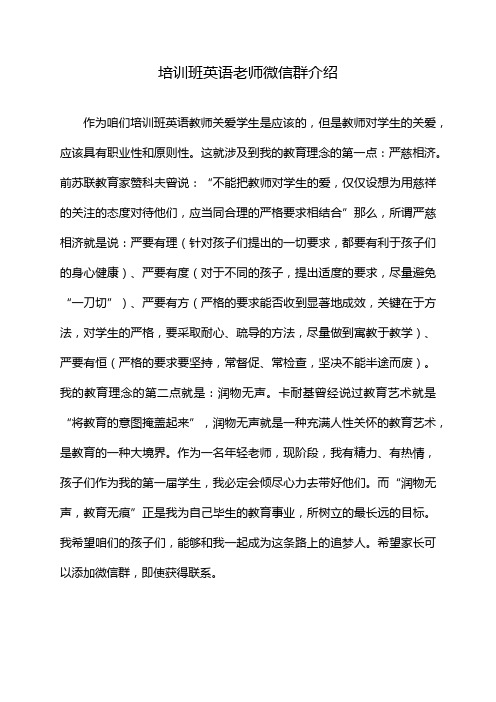
培训班英语老师微信群介绍
作为咱们培训班英语教师关爱学生是应该的,但是教师对学生的关爱,应该具有职业性和原则性。
这就涉及到我的教育理念的第一点:严慈相济。
前苏联教育家赞科夫曾说:“不能把教师对学生的爱,仅仅设想为用慈祥的关注的态度对待他们,应当同合理的严格要求相结合”那么,所谓严慈相济就是说:严要有理(针对孩子们提出的一切要求,都要有利于孩子们的身心健康)、严要有度(对于不同的孩子,提出适度的要求,尽量避免“一刀切”)、严要有方(严格的要求能否收到显著地成效,关键在于方法,对学生的严格,要采取耐心、疏导的方法,尽量做到寓教于教学)、严要有恒(严格的要求要坚持,常督促、常检查,坚决不能半途而废)。
我的教育理念的第二点就是:润物无声。
卡耐基曾经说过教育艺术就是“将教育的意图掩盖起来”,润物无声就是一种充满人性关怀的教育艺术,是教育的一种大境界。
作为一名年轻老师,现阶段,我有精力、有热情,孩子们作为我的第一届学生,我必定会倾尽心力去带好他们。
而“润物无声,教育无痕”正是我为自己毕生的教育事业,所树立的最长远的目标。
我希望咱们的孩子们,能够和我一起成为这条路上的追梦人。
希望家长可以添加微信群,即使获得联系。
利用微信群提高小学生英语学习兴趣
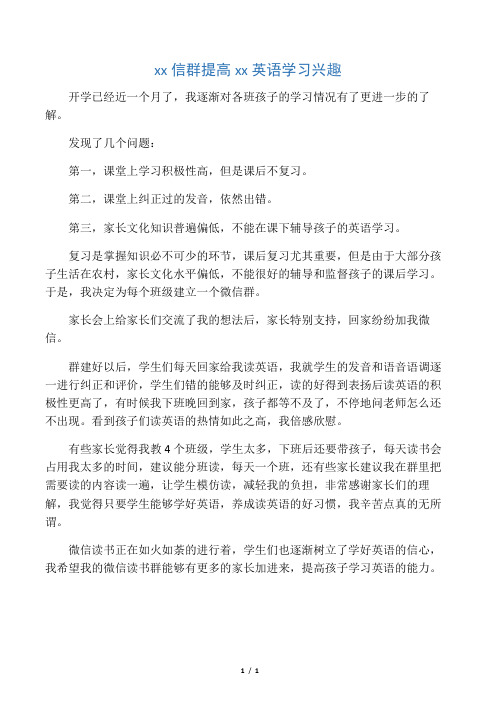
xx信群提高xx英语学习兴趣
开学已经近一个月了,我逐渐对各班孩子的学习情况有了更进一步的了解。
发现了几个问题:
第一,课堂上学习积极性高,但是课后不复习。
第二,课堂上纠正过的发音,依然出错。
第三,家长文化知识普遍偏低,不能在课下辅导孩子的英语学习。
复习是掌握知识必不可少的环节,课后复习尤其重要,但是由于大部分孩子生活在农村,家长文化水平偏低,不能很好的辅导和监督孩子的课后学习。
于是,我决定为每个班级建立一个微信群。
家长会上给家长们交流了我的想法后,家长特别支持,回家纷纷加我微信。
群建好以后,学生们每天回家给我读英语,我就学生的发音和语音语调逐一进行纠正和评价,学生们错的能够及时纠正,读的好得到表扬后读英语的积极性更高了,有时候我下班晚回到家,孩子都等不及了,不停地问老师怎么还不出现。
看到孩子们读英语的热情如此之高,我倍感欣慰。
有些家长觉得我教4个班级,学生太多,下班后还要带孩子,每天读书会占用我太多的时间,建议能分班读,每天一个班,还有些家长建议我在群里把需要读的内容读一遍,让学生模仿读,减轻我的负担,非常感谢家长们的理解,我觉得只要学生能够学好英语,养成读英语的好习惯,我辛苦点真的无所谓。
微信读书正在如火如荼的进行着,学生们也逐渐树立了学好英语的信心,我希望我的微信读书群能够有更多的家长加进来,提高孩子学习英语的能力。
1/ 1。
M1U1Gostraighton.教学设计-Unit1-四年级上册英语(外研三起点)

- 在线英语学习平台:介绍一些在线英语学习平台,如英语流利说、多邻国等,让学生自主学习英语。
- 英语绘本和故事书:推荐一些英语绘本和故事书,让学生阅读并练习描述方向和地点的能力。
2. 拓展建议:
- 让学生收集自己和家人去过的旅游景点地图,用英语描述路线和景点,可以互相分享和讨论。
强调方位和地点词汇在日常生活中的价值和作用,鼓励学生进一步探索和应用方位和地点词汇。
布置课后作业:让学生撰写一篇关于方位和地点词汇的短文或报告,以巩固学习效果。
六、教学资源拓展
1. 拓展资源:
- 地图和城市导览图:提供不同城市的地图和导览图,让学生练习如何用英语描述方向和地点。
- 旅行指南:提供旅行指南或旅游手册,让学生阅读并练习如何用英语描述景点和地标。
- 组织一次角色扮演活动,学生扮演旅游指南,向其他学生介绍虚构或真实的城市或景点,使用英语进行描述。
- 鼓励学生观看英语电影和电视剧,注意其中的方向和地点描述,可以进行暂停和模仿练习。
- 利用在线英语学习平台,让学生参与英语听力和口语练习,提高他们的方向和地点描述能力。
- 让学生阅读英语绘本和故事书,注意其中的方向和地点描述,可以进行思考和讨论。
四、教学资源
软硬件资源:
- 教室内的多媒体投影仪和屏幕
- 计算机和投影仪
- 教学挂图和海报
- 教学卡片和实物模型
课程平台:
- 班级微信群和QQ群
- 学校的学习管理系统
信息化资源:
- 英语学习软件和应用程序
- 在线英语学习网站和视频资源
- 英语学习音频材料
教学手段:
英语词根大全(共910个)
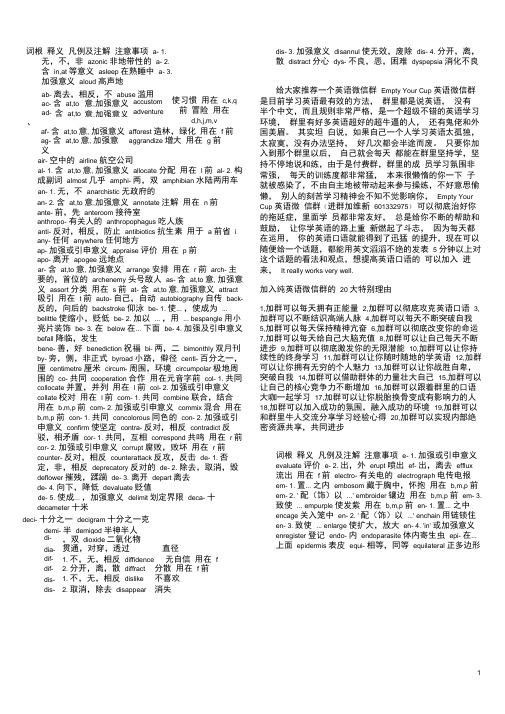
air- 空中的 airline 航空公司al- 1. 含 at,to 意, 加强意义 allocate 分配 用在 l 前 al- 2. 构成副词 almost 几乎 amphi- 两,双 amphibian 水陆两用车 an- 1. 无,不 anarchistic 无政府的an- 2. 含 at,to 意,加强意义 annotate 注解 用在 n 前 ante- 前,先 anteroom 接待室anthropo- 有关人的 anthropophagus 吃人族anti- 反对,相反,防止 antibiotics 抗生素 用于 a 前省 i any- 任何 anywhere 任何地方ap- 加强或引申意义 appraise 评价 用在 p 前 apo- 离开 apogee 远地点ar- 含 at,to 意, 加强意义 arrange 安排 用在 r 前 arch- 主要的,首位的 archenemy 头号敌人 as- 含 at,to 意, 加强意义 assort 分类 用在 s 前 at- 含 at,to 意, 加强意义 attract 吸引 用在 t 前 auto- 自己,自动 autobiography 自传 back- 反的,向后的 backstroke 仰泳 be- 1. 使... ,使成为 ... belittle 使缩小,贬低 be- 2. 加以 ... ,用 ... bespangle 用小亮片装饰 be- 3. 在 below 在... 下面 be- 4. 加强及引申意义 befall 降临,发生bene- 善,好 benediction 祝福 bi- 两,二 bimonthly 双月刊 by- 旁,侧,非正式 byroad 小路,僻径 centi- 百分之一,厘 centimetre 厘米 circum- 周围,环境 circumpolar 极地周围的 co- 共同 cooperation 合作 用在元音字前 col- 1. 共同 collocate 并置,并列 用在 l 前 col- 2. 加强或引申意义 collate 校对 用在 l 前 com- 1. 共同 combine 联合,结合 用在 b,m,p 前 com- 2. 加强或引申意义 commix 混合 用在 b,m,p 前 con- 1. 共同 concolorous 同色的 con- 2. 加强或引申意义 confirm 使坚定 contra- 反对,相反 contradict 反驳,相矛盾 cor- 1. 共同,互相 correspond 共鸣 用在 r 前 cor- 2. 加强或引申意义 corrupt 腐败,败坏 用在 r 前 counter- 反对,相反 counterattack 反攻,反击 de- 1. 否定,非,相反 deprecatory 反对的 de- 2. 除去,取消,毁 deflower 摧残,蹂躏 de- 3. 离开 depart 离去 de- 4. 向下,降低 devaluate 贬值de- 5. 使成... ,加强意义 delimit 划定界限 deca- 十 decameter 十米deci- 十分之一 decigram 十分之一克demi- 半 demigod 半神半人 di- 二 ,双 dioxide 二氧化物dia-贯通,对穿,透过 直径 dif- 1. 不,无,相反 diffidence 无自信 用在 f dif- 2. 分开,离,散 diffract 分散 用在 f 前 dis- 1. 不,无,相反 dislike 不喜欢 dis- 2. 取消,除去 disappear 消失dis- 3. 加强意义 disannul 使无效,废除 dis- 4. 分开,离,散 distract 分心 dys- 不良,恶,困难 dyspepsia 消化不良给大家推荐一个英语微信群 Empty Your Cup 英语微信群是目前学习英语最有效的方法, 群里都是说英语, 没有 半个中文,而且规则非常严格,是一个超级不错的英语学习环境, 群里有好多英语超好的超牛逼的人, 还有鬼佬和外国美眉。
初中我的计划学习英语作文
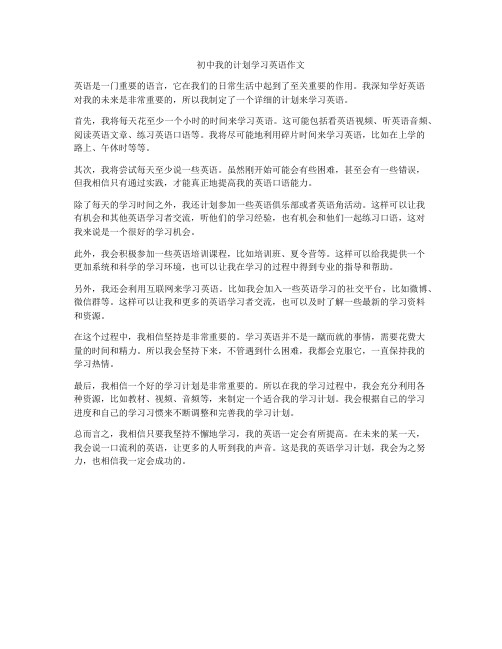
初中我的计划学习英语作文英语是一门重要的语言,它在我们的日常生活中起到了至关重要的作用。
我深知学好英语对我的未来是非常重要的,所以我制定了一个详细的计划来学习英语。
首先,我将每天花至少一个小时的时间来学习英语。
这可能包括看英语视频、听英语音频、阅读英语文章、练习英语口语等。
我将尽可能地利用碎片时间来学习英语,比如在上学的路上、午休时等等。
其次,我将尝试每天至少说一些英语。
虽然刚开始可能会有些困难,甚至会有一些错误,但我相信只有通过实践,才能真正地提高我的英语口语能力。
除了每天的学习时间之外,我还计划参加一些英语俱乐部或者英语角活动。
这样可以让我有机会和其他英语学习者交流,听他们的学习经验,也有机会和他们一起练习口语,这对我来说是一个很好的学习机会。
此外,我会积极参加一些英语培训课程,比如培训班、夏令营等。
这样可以给我提供一个更加系统和科学的学习环境,也可以让我在学习的过程中得到专业的指导和帮助。
另外,我还会利用互联网来学习英语。
比如我会加入一些英语学习的社交平台,比如微博、微信群等。
这样可以让我和更多的英语学习者交流,也可以及时了解一些最新的学习资料和资源。
在这个过程中,我相信坚持是非常重要的。
学习英语并不是一蹴而就的事情,需要花费大量的时间和精力。
所以我会坚持下来,不管遇到什么困难,我都会克服它,一直保持我的学习热情。
最后,我相信一个好的学习计划是非常重要的。
所以在我的学习过程中,我会充分利用各种资源,比如教材、视频、音频等,来制定一个适合我的学习计划。
我会根据自己的学习进度和自己的学习习惯来不断调整和完善我的学习计划。
总而言之,我相信只要我坚持不懈地学习,我的英语一定会有所提高。
在未来的某一天,我会说一口流利的英语,让更多的人听到我的声音。
这是我的英语学习计划,我会为之努力,也相信我一定会成功的。
初中英语教研微信群名称(3篇)

第1篇一、寓意丰富型1. 慧眼识珠英语教研群寓意:强调教师在英语教学过程中要善于发现学生的潜能,激发学生的学习兴趣。
2. 悦学英语教学研究群寓意:倡导以学生为本,关注学生的情感体验,营造愉悦的英语学习氛围。
3. 乘风破浪英语教研团队寓意:鼓励教师们在教学道路上勇往直前,不断挑战自我,提高教学水平。
4. 魅力英语教学研讨群寓意:强调英语教学要充满魅力,激发学生的兴趣,提高教学质量。
5. 智慧星英语教研联盟寓意:汇聚优秀英语教师,共同探讨教学方法,为学生提供更优质的教育资源。
二、朗朗上口型1. 英语角寓意:英语教研群就像一个英语角,教师们可以在这里交流、分享、学习。
2. 英语梦工厂寓意:鼓励教师们发挥创意,为学生打造一个充满乐趣的英语学习环境。
3. 英语乐园寓意:营造一个轻松愉快的英语学习氛围,让学生在快乐中学习英语。
4. 英语星球寓意:将英语教研群比作一个星球,汇聚来自各地的优秀英语教师,共同探讨教学方法。
5. 英语花园寓意:让英语教研群成为一片美丽的花园,教师们在其中交流、学习、成长。
三、形象生动型1. 英语小船队寓意:教师们携手共进,像一艘小船在英语教学的大海中航行。
2. 英语蜜蜂巢寓意:教师们团结协作,像蜜蜂一样辛勤工作,为学生提供优质的教育资源。
3. 英语侦探社寓意:教师们像侦探一样,不断探索、研究,为学生找到最适合他们的英语学习方法。
4. 英语彩虹桥寓意:搭建一座连接教师与学生、理论与实践的彩虹桥,让英语教学更加美好。
5. 英语绿茵场寓意:英语教研群是一个充满活力、充满竞争的绿茵场,教师们在其中不断提升自己。
四、特色鲜明型1. 英语学霸俱乐部寓意:聚集各路英语学霸,共同探讨学习方法,提高教学质量。
2. 英语教学高手营寓意:邀请教学经验丰富的教师,分享教学心得,助力教师成长。
3. 英语风采展示台寓意:为教师提供一个展示教学风采的舞台,分享教学成果。
4. 英语智慧树寓意:教师们汲取教学智慧,共同培养一棵茁壮成长的英语智慧树。
英文数字次数表示

Zero 0 One 1 Two 2 Three 3 Four 4 Five 5 Six 6 Seven 7 Eight 8 Nine 9 Ten 10 Eleven11 Twelve12 Thirteen13 Fourteen14 Fifteen 15 Sixteen 16Seventeen 17 Eighteen 18 Nineteen 19 Twenty 20 Thirty 30 Forty 40Fifty 50 Sixty 60 Seventy 70 Eighty 80 Ninety 90 Hundred 100 Thousand 1000 First 第一Second 第二Third 第三Forth 第四Fifth 第五Sixth 第六给大家推荐一个英语微信群Empty Your Cup英语微信群是目前学习英语最有效的方法,群里都是说英语,没有半个中文,而且规则非常严格,是一个超级不错的英语学习环境,群里有好多英语超好的超牛逼的人,还有鬼佬和外国美眉。
其实坦白说,如果自己一个人学习英语太孤独,太寂寞,没有办法坚持,好几次都会半途而废。
只要你加入到那个群里以后,自己就会每天都能在群里坚持学,坚持不停地说和练,由于是付费群,群里的成员学习氛围非常强,每天的训练度都非常猛,本来很懒惰的你一下子就被感染了,不由自主地被带动起来参与操练,不好意思偷懒,别人的刻苦学习精神会不知不觉影响你,Empty Your Cup英语微信群(进群加为星601332975)可以彻底治好你的拖延症,里面学员都非常友好,总是给你不断的帮助和鼓励,让你在学英语的路上重新燃起了斗志,因为每天都在运用,你的英语口语就能得到了迅猛的提升,现在可以随便给一个话题,都能用英文滔滔不绝的发表5分钟以上对这个话题的看法和观点,想提高英语口语的可以加入进来,It really works very well.。
度量衡等名词作主语时谓语用单数还是复数表示时间
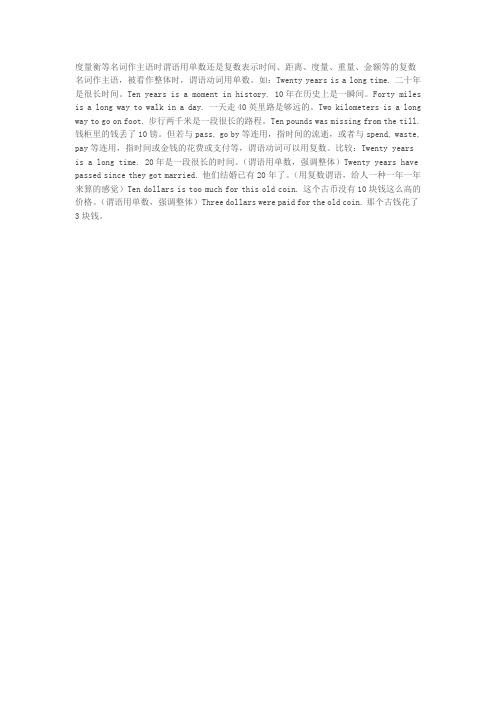
度量衡等名词作主语时谓语用单数还是复数表示时间、距离、度量、重量、金额等的复数名词作主语,被看作整体时,谓语动词用单数。
如:Twenty years is a long time. 二十年是很长时间。
Ten years is a moment in history. 10年在历史上是一瞬间。
Forty miles is a long way to walk in a day. 一天走40英里路是够远的。
Two kilometers is a long way to go on foot. 步行两千米是一段很长的路程。
Ten pounds was missing from the till. 钱柜里的钱丢了10镑。
但若与pass, go by等连用,指时间的流逝,或者与spend, waste, pay等连用,指时间或金钱的花费或支付等,谓语动词可以用复数。
比较:Twenty years is a long time. 20年是一段很长的时间。
(谓语用单数,强调整体)Twenty years have passed since they got married. 他们结婚已有20年了。
(用复数谓语,给人一种一年一年来算的感觉)Ten dollars is too much for this old coin. 这个古币没有10块钱这么高的价格。
(谓语用单数,强调整体)Three dollars were paid for the old coin. 那个古钱花了3块钱。
给大家推荐一个英语微信群Empty Your Cup英语微信群是目前学习英语最有效的方法,群里都是说英语,没有半个中文,而且规则非常严格,是一个超级不错的英语学习环境,群里有好多英语超好的超牛逼的人,还有鬼佬和外国美眉。
其实坦白说,如果自己一个人学习英语太孤独,太寂寞,没有办法坚持,好几次都会半途而废。
只要你加入到那个群里以后,自己就会每天都能在群里坚持学,坚持不停地说和练,由于是付费群,群里的成员学习氛围非常强,每天的训练度都非常猛,本来很懒惰的你一下子就被感染了,不由自主地被带动起来参与操练,不好意思偷懒,别人的刻苦学习精神会不知不觉影响你,Empty Your Cup英语微信群(进群加为星601332975)可以彻底治好你的拖延症,里面学员都非常友好,总是给你不断的帮助和鼓励,让你在学英语的路上重新燃起了斗志,因为每天都在运用,你的英语口语就能得到了迅猛的提升,现在可以随便给一个话题,都能用英文滔滔不绝的发表5分钟以上对这个话题的看法和观点,想提高英语口语的可以加入进来,It really works very well.。
英语交流微信群2018_如何加入英语微信群
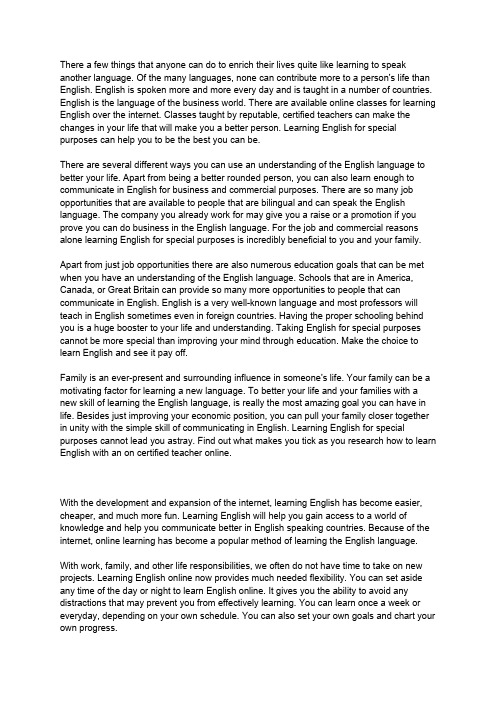
There a few things that anyone can do to enrich their lives quite like learning to speak another language. Of the many languages, none can contribute more to a person's life than English. English is spoken more and more every day and is taught in a number of countries. English is the language of the business world. There are available online classes for learning English over the internet. Classes taught by reputable, certified teachers can make the changes in your life that will make you a better person. Learning English for special purposes can help you to be the best you can be.There are several different ways you can use an understanding of the English language to better your life. Apart from being a better rounded person, you can also learn enough to communicate in English for business and commercial purposes. There are so many job opportunities that are available to people that are bilingual and can speak the English language. The company you already work for may give you a raise or a promotion if you prove you can do business in the English language. For the job and commercial reasons alone learning English for special purposes is incredibly beneficial to you and your family.Apart from just job opportunities there are also numerous education goals that can be met when you have an understanding of the English language. Schools that are in America, Canada, or Great Britain can provide so many more opportunities to people that can communicate in English. English is a very well-known language and most professors will teach in English sometimes even in foreign countries. Having the proper schooling behind you is a huge booster to your life and understanding. Taking English for special purposes cannot be more special than improving your mind through education. Make the choice to learn English and see it pay off.Family is an ever-present and surrounding influence in someone's life. Your family can be a motivating factor for learning a new language. To better your life and your families with a new skill of learning the English language, is really the most amazing goal you can have in life. Besides just improving your economic position, you can pull your family closer together in unity with the simple skill of communicating in English. Learning English for special purposes cannot lead you astray. Find out what makes you tick as you research how to learn English with an on certified teacher online.With the development and expansion of the internet, learning English has become easier, cheaper, and much more fun. Learning English will help you gain access to a world of knowledge and help you communicate better in English speaking countries. Because of the internet, online learning has become a popular method of learning the English language.With work, family, and other life responsibilities, we often do not have time to take on new projects. Learning English online now provides much needed flexibility. You can set aside any time of the day or night to learn English online. It gives you the ability to avoid any distractions that may prevent you from effectively learning. You can learn once a week or everyday, depending on your own schedule. You can also set your own goals and chart your own progress.给大家推荐一个英语微信群-Empty Your Cup英语微信群是目前学习英语最有效的方法,群里都是说英语,没有半个中文,而且规则非常严格,是一个超级不错的英语学习环境,群里有好多英语超好的超牛逼的人,还有鬼佬和外国美眉。
纯英文英语学习群-英语交流群微信

英文表达增色的100句经典句子1.Time flies. 时光易逝。
2. Time is money. 一寸光阴一寸金。
3. Time and tide wait for no man. 岁月无情;岁月易逝;岁月不待人。
4. Time tries all. 时间检验一切。
5. Time tries truth. 时间检验真理。
6. Time past cannot be called back again. 光阴一去不复返。
7. All time is no time when it is past. 光阴一去不复返。
8. No one can call back yesterday;Yesterday will not be called again. 昨日不复来。
9. Tomorrow comes never. 切莫依赖明天。
10.One today is worth two tomorrows. 一个今天胜似两个明天。
11.The morning sun never lasts a day. 好景不常;朝阳不能光照全日。
12.Christmas comes but once a year. 圣诞一年只一度。
13.Pleasant hours fly past. 快乐时光去如飞。
14.Happiness takes no account of time. 欢娱不惜时光逝。
给大家推荐一个英语微信群-Empty Your Cup英语微信群是目前学习英语最有效的方法,群里都是说英语,没有半个中文,而且规则非常严格,是一个超级不错的英语学习环境,群里有好多英语超好的超牛逼的人,还有鬼佬和外国美眉。
其实坦白说,如果自己一个人学习英语太孤独,太寂寞,没有办法坚持,好几次都会半途而废。
只要你加入到那个群里以后,自己就会每天都能在群里坚持学,坚持不停地说和练,由于是付费群,群里的成员学习氛围非常强,每天的训练度都非常猛,本来很懒惰的你一下子就被感染了,不由自主地被带动起来参与操练,不好意思偷懒,别人的刻苦学习精神会不知不觉影响你,Empty Your Cup英语微信群(进群加喂新 601332975)可以彻底治好你的拖延症,里面学员都非常友好,总是给你不断的帮助和鼓励,让你在学英语的路上重新燃起了斗志,因为每天都在运用,你的英语口语就能得到了迅猛的提升,现在可以随便给一个话题,都能用英文滔滔不绝的发表5分钟以上对这个话题的看法和观点,想提高英语口语的 可以加入进来,It really works very well. 15.Time tames the strongest grief. 时间能缓和极度的悲痛。
初中英语教研组亮点(3篇)

第1篇一、教研组简介初中英语教研组是一支充满活力、富有创新精神的团队。
我们以“提高教学质量,促进学生全面发展”为宗旨,以“团结协作、追求卓越”为团队精神,致力于探索初中英语教学的新方法、新思路,为学生的英语学习提供优质的教育资源。
二、教研组亮点1. 高度重视教师队伍建设(1)加强师德师风建设。
教研组定期组织教师学习《中小学教师职业道德规范》,引导教师树立正确的教育观、学生观,以高尚的师德影响学生。
(2)提升教师专业素养。
教研组定期开展教师培训活动,邀请专家、学者为教师们讲解最新的教育理念、教学方法,提高教师的专业水平。
(3)优化教师结构。
教研组注重选拔和培养优秀青年教师,通过师徒结对、教学研讨等形式,促进青年教师快速成长。
2. 创新教学模式,提高教学质量(1)开展“翻转课堂”教学模式。
通过课前自主学习、课中互动交流、课后巩固提升,激发学生的学习兴趣,提高课堂效率。
(2)实施“分层教学”策略。
针对学生的个体差异,将学生分为不同层次,制定相应的教学目标和方法,确保每个学生都能在英语学习中取得进步。
(3)引入“情景教学”方法。
通过创设真实、生动的教学情境,让学生在轻松愉快的氛围中学习英语,提高学生的实际运用能力。
3. 加强教学研究,促进教师成长(1)开展课题研究。
教研组定期组织教师申报和参与课题研究,通过实践、总结、反思,不断提高教师的教育教学水平。
(2)举办教学研讨活动。
教研组定期组织教师开展教学研讨活动,分享教学经验,共同探讨解决教学难题的方法。
(3)开展教师评课活动。
教研组组织教师进行相互评课,以评促教,以评促改,提高教师的教学能力。
4. 注重家校合作,共同促进学生学习(1)建立家校联系机制。
教研组定期与家长沟通,了解学生在家的学习情况,共同制定学生的学习计划。
(2)开展家长学校活动。
教研组定期邀请家长参加家长学校活动,分享教育经验,提高家长的教育素养。
(3)举办亲子活动。
教研组组织亲子活动,增进家长与学生的感情,共同营造良好的家庭学习氛围。
2025年七年级英语教研组下学期工作总结(五篇)
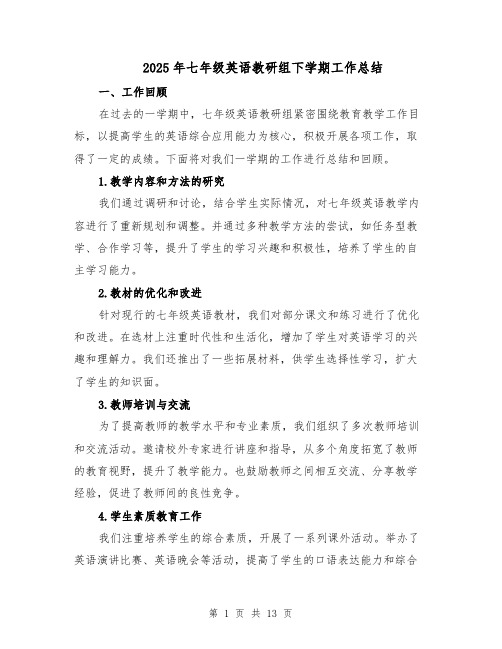
2025年七年级英语教研组下学期工作总结一、工作回顾在过去的一学期中,七年级英语教研组紧密围绕教育教学工作目标,以提高学生的英语综合应用能力为核心,积极开展各项工作,取得了一定的成绩。
下面将对我们一学期的工作进行总结和回顾。
1.教学内容和方法的研究我们通过调研和讨论,结合学生实际情况,对七年级英语教学内容进行了重新规划和调整。
并通过多种教学方法的尝试,如任务型教学、合作学习等,提升了学生的学习兴趣和积极性,培养了学生的自主学习能力。
2.教材的优化和改进针对现行的七年级英语教材,我们对部分课文和练习进行了优化和改进。
在选材上注重时代性和生活化,增加了学生对英语学习的兴趣和理解力。
我们还推出了一些拓展材料,供学生选择性学习,扩大了学生的知识面。
3.教师培训与交流为了提高教师的教学水平和专业素质,我们组织了多次教师培训和交流活动。
邀请校外专家进行讲座和指导,从多个角度拓宽了教师的教育视野,提升了教学能力。
也鼓励教师之间相互交流、分享教学经验,促进了教师间的良性竞争。
4.学生素质教育工作我们注重培养学生的综合素质,开展了一系列课外活动。
举办了英语演讲比赛、英语晚会等活动,提高了学生的口语表达能力和综合运用能力。
组织了英语兴趣小组,鼓励学生参与其中,培养他们的学习兴趣和爱好。
二、存在问题在工作中,我们也发现了一些问题和不足之处,需要深入研究和探讨解决方法。
1.知识结构不完整部分学生在学习英语时,缺乏一个完整的知识结构,导致在后续学习中无法很好地理解和运用。
我们需要加强学生的基础知识学习,培养他们的语言能力和语言意识,提高整体学习质量。
2.学习方法不科学一部分学生在学习英语时,仍然采用死记硬背的方式,缺少主动学习的意识和方法。
我们需要引导学生正确的学习方法,培养他们的自主学习能力,提高学习效果。
3.听说能力薄弱由于学生平时接触英语的机会较少,导致他们的听说能力相对较弱。
我们应该注重培养学生的听说能力,增加听说训练的时间和机会,提高学生的口语表达能力和听力理解能力。
信息技术与初中英语教学的融合探索
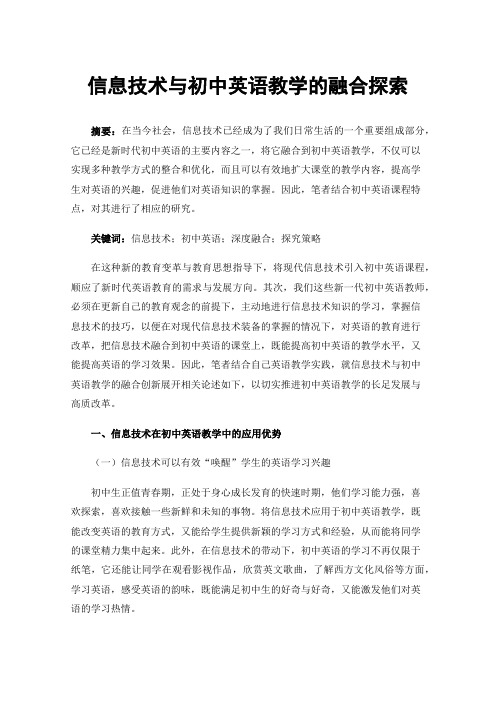
信息技术与初中英语教学的融合探索摘要:在当今社会,信息技术已经成为了我们日常生活的一个重要组成部分,它已经是新时代初中英语的主要内容之一,将它融合到初中英语教学,不仅可以实现多种教学方式的整合和优化,而且可以有效地扩大课堂的教学内容,提高学生对英语的兴趣,促进他们对英语知识的掌握。
因此,笔者结合初中英语课程特点,对其进行了相应的研究。
关键词:信息技术;初中英语;深度融合;探究策略在这种新的教育变革与教育思想指导下,将现代信息技术引入初中英语课程,顺应了新时代英语教育的需求与发展方向。
其次,我们这些新一代初中英语教师,必须在更新自己的教育观念的前提下,主动地进行信息技术知识的学习,掌握信息技术的技巧,以便在对现代信息技术装备的掌握的情况下,对英语的教育进行改革,把信息技术融合到初中英语的课堂上,既能提高初中英语的教学水平,又能提高英语的学习效果。
因此,笔者结合自己英语教学实践,就信息技术与初中英语教学的融合创新展开相关论述如下,以切实推进初中英语教学的长足发展与高质改革。
一、信息技术在初中英语教学中的应用优势(一)信息技术可以有效“唤醒”学生的英语学习兴趣初中生正值青春期,正处于身心成长发育的快速时期,他们学习能力强,喜欢探索,喜欢接触一些新鲜和未知的事物。
将信息技术应用于初中英语教学,既能改变英语的教育方式,又能给学生提供新颖的学习方式和经验,从而能将同学的课堂精力集中起来。
此外,在信息技术的带动下,初中英语的学习不再仅限于纸笔,它还能让同学在观看影视作品,欣赏英文歌曲,了解西方文化风俗等方面,学习英语,感受英语的韵味,既能满足初中生的好奇与好奇,又能激发他们对英语的学习热情。
(二)信息技术可以切实丰富学生的英语学习资源传统的初中英语教学,主要是“教师讲、学生听”,学习资源主要来源于课本、试卷、教辅材料,以及教师多年的教学经验。
然而,将信息技术导入初中英语,不但可以将呆板的英文字母变成生动形象的文字,更可以利用网路的资讯,为同学提供听说读写等各方面的英语学习资料,从而达到既充实又充实的课堂教学,又能有效打破英语与英语学习的时空“壁垒”,让学生随时随地随地随心学习英语,真正促进初中阶段英语学习的可持续性发展。
小学六年级上册英语同步练习题

小学六年级上册英语同步练习题学校六年级上册英语同步练习题作为学校生,想提高英语成果,看电影学习英语也是不错的方式,可以保持对学习的新奇感,搭配字幕观看,还有助于记忆单词,帮忙订正不良的口语习惯。
下面是我为大家整理的六年级上册英语同步练习题,期望对您有所帮忙!六年级上册英语同步练习题一、用所给单词的`适当形式填空。
1、Thisballis_______(big)thanthatone.2、Let’smakea________(雪人)together.3、________(当心)!Herecomesabus.4、It’ssnowy,I________(be)verycold.二、选择正确的答案。
()1、Itiscoldtoday.Take________yourjacketandput________yourcoat.A、off,onB、for,onC、off,inD、on,on()2、________atallgirl!A、WhatB、HowC、What’sD、Howis()3、I________athomeyesterday.A、wasB、wereC、areD、is()4、It’steno’clock.LiPing________TVinthebedroom.A、watchB、iswatchingC、watchesD、watched英语学习技巧1、尽可能多的讲英语学习英语就是为了能够更好的沟通,因此英语的“说”的力量是至关重要的,不过我们四周许多的朋友并不能开口说好英语,这主要也跟他们的心理素养有关,因此首先要克服自己的心理障碍,尽可能多的开口讲英语,同时试着将大部分的时间花在和比你讲得好的人交谈。
2、看英语电视或者听英语录音正确的学习英语,在听和说里面,要留意把握节奏感,这种节奏感可以通过观看英语电视或者录音来体会,针对初级学习者,要留意多听英语录音,试着听话语的速度,以及它是在哪一种语境下发音的,语调又是什么样的,在外界环境下的发音是可以让学习者真实感受到语言的特点的。
英语辅导机构的社群建设方案

英语辅导机构的社群建设方案英语辅导机构的社群建设方案一、目标设定1. 提高学员之间的互动和交流程度,激发学习兴趣;2. 建立学员与教师之间的密切关系,提供更个性化的教育服务;3. 增加学员对英语辅导机构的忠诚度和参与度。
二、社群平台选择选择适合我们英语辅导机构的社群平台,例如微信群、QQ群、微博、微信公众号等。
考虑到我们的目标用户是学生群体,因此微信群和微信公众号可能是最为合适的选择。
三、社群内容规划1. 学习资源分享:每天定时分享英语学习资料、练习题等,激发学员学习英语的积极性。
2. 互助学习:组织学员之间的互动学习活动,例如每周举办一个小组讨论或在线辩论活动,以提高学员英语口语表达能力。
3. 名师在线答疑:在指定的时间段内,我们请资深教师在线回答学员提出的问题,提供学习咨询和辅导。
4. 优秀学员展示:定期选取学员的英语学习成果,发布在社群中展示,激励其他学员努力学习,也增强学员的归属感。
5. 活动推广:定期举办线上或线下的英语学习活动,例如英语角、听力比赛等,提高学员参与度和社群积极性。
四、社群管理1. 定期更新社群内容,确保学员的参与度和互动程度,以及对教师的反馈;2. 设立专人负责社群管理,包括内容审核、问题解答等;3. 鼓励学员主动分享学习经验和心得,提高社群活跃度;4. 建立活跃的社群管理员团队,负责监督社群中的互动,保持秩序和正面讨论氛围。
五、宣传推广1. 在线下辅导课程中积极宣传社群平台和内容,鼓励学员参与;2. 利用微信朋友圈等平台推广社群,吸引更多学员加入;3. 建立线上推广活动,例如邀请大V教育博主参与社群活动,提高知名度和影响力。
六、数据分析与改进1. 建立社群数据统计和分析机制,定期进行社群数据分析,了解学员参与程度和内容反馈;2. 根据数据分析结果,及时调整和改进社群内容和管理措施。
以上是英语辅导机构的社群建设方案的相关参考内容,通过社群建设,我们可以提高学员的参与度与互动程度,凝聚学员群体,提供更个性化的教育服务,为学员提供更好的学习平台和机会。
英语中表示“本想”的6种时态

英语中表示“本想”的6种时态1. 用c ome / go 等动词的过去进行时表示。
如:We were coming to see you, but it rained (so we didn’t). 我们本打算来看你的,只是下起雨来了。
I was trying to help but I screwed up again. 我本想帮忙,反而又把事情搞糟了。
2. 用w as [were] going to do sth 表示。
如:She was going to attend the concert last night, but she was too busy. 她昨晚本想去听音乐会的,但她太忙了。
3. 用t hink, hope, plan, mean, expect, intend, suppose 等动词的过去完成时表示。
如:I had meant to come, but something happened. 我本想来,但有事就没有来。
I had intended to speak, but time did not permit. 我本想发言,但时间不允许。
We had hoped that you would come to see us, but you didn't. 我们本想你来看我们的,但你没有来。
We had thought to return early but they wouldn't let us go. 我们本想早回来的,但他们不让我们走。
若不至于引导误解,有时也可用以上动词的一般过去时表示“本想”。
如:I thought I could go, but I can’t. 我原以为我能去,但我(现在)去不了。
I meant to reason with you, but you won't reason. 我本想和你讲道理,但你不肯讲道理。
考研英语真题试卷怎么买
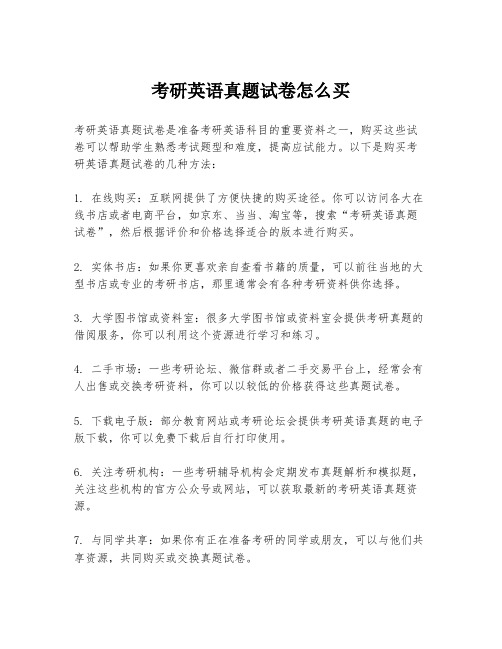
考研英语真题试卷怎么买
考研英语真题试卷是准备考研英语科目的重要资料之一,购买这些试卷可以帮助学生熟悉考试题型和难度,提高应试能力。
以下是购买考研英语真题试卷的几种方法:
1. 在线购买:互联网提供了方便快捷的购买途径。
你可以访问各大在线书店或者电商平台,如京东、当当、淘宝等,搜索“考研英语真题试卷”,然后根据评价和价格选择适合的版本进行购买。
2. 实体书店:如果你更喜欢亲自查看书籍的质量,可以前往当地的大型书店或专业的考研书店,那里通常会有各种考研资料供你选择。
3. 大学图书馆或资料室:很多大学图书馆或资料室会提供考研真题的借阅服务,你可以利用这个资源进行学习和练习。
4. 二手市场:一些考研论坛、微信群或者二手交易平台上,经常会有人出售或交换考研资料,你可以以较低的价格获得这些真题试卷。
5. 下载电子版:部分教育网站或考研论坛会提供考研英语真题的电子版下载,你可以免费下载后自行打印使用。
6. 关注考研机构:一些考研辅导机构会定期发布真题解析和模拟题,关注这些机构的官方公众号或网站,可以获取最新的考研英语真题资源。
7. 与同学共享:如果你有正在准备考研的同学或朋友,可以与他们共享资源,共同购买或交换真题试卷。
购买考研英语真题试卷时,请注意以下几点:
- 确认试卷的版本和年份是否最新,以确保练习的针对性。
- 检查试卷的完整性和清晰度,确保没有遗漏或模糊不清的部分。
- 考虑购买包含详细解析的版本,这有助于你更好地理解题目和答案。
最后,购买真题试卷只是复习的一部分,重要的是要通过不断的练习
和总结,提高自己的英语水平和应试技巧。
祝你考研成功!。
以帮助新生适应新的环境和学术研究为题的英语作文。

帮助新生适应新环境和学术研究英语作文1英文作文:Last semester, a new batch of freshmen arrived on campus. I remembered how I felt when I was a freshman, a bit lost and confused. So, I decided to help them adapt to the new environment and academic research.I took the initiative to approach some freshmen and offered to show them around the campus. As we walked, I pointed out the different buildings and facilities, like the library, the cafeteria, and the sports center. I also explained the school's规章制度, such as the opening hours of the library and the attendance requirements for classes.After the campus tour, I sat down with a few freshmen and helped them制定学习计划. I shared my own experiences and tips on how to manage time effectively and balance academics with extracurricular activities. We talked about setting goals and breaking them down into smaller steps.One freshman named Lily was particularly worried about her upcoming English class. I encouraged her and offered to study with her. We met up a few times a week to practice speaking and writing English. As time went by, Lily became more confident and started to enjoy her classes.Helping these freshmen not only made them feel welcome and supported but also gave me a great sense of satisfaction. It reminded me of the importance of kindness and paying it forward. I realized that even a small act of help can make a big difference in someone's life.中文翻译:上个学期,一批新生来到了校园。
- 1、下载文档前请自行甄别文档内容的完整性,平台不提供额外的编辑、内容补充、找答案等附加服务。
- 2、"仅部分预览"的文档,不可在线预览部分如存在完整性等问题,可反馈申请退款(可完整预览的文档不适用该条件!)。
- 3、如文档侵犯您的权益,请联系客服反馈,我们会尽快为您处理(人工客服工作时间:9:00-18:30)。
Maps offer ESL students with an excellent format for learning English. Students can learn and use both concrete and difficult abstract concepts when learning English with maps.
Students can learn basic math terms for scale and distance. Most maps have a legend which lists dimensions, symbols and content. The students can learn how the map is used to represent the world using both the metric and imperial measurement terms and distances. Maps show scale and a physical distance representation using graphs. It is easy for students to see the one centimeter or one inch and how it represents kilometers or miles in the real world. Students can also learn how to convert measurements between the metric and imperial systems.
Students can use maps to learn mathematical ratios. Using the map scales the students can learn what one-to-one or 1:700,000 really means and how ratios are used to draw maps in the correct proportions.
Students can use maps to learn spatial relationships. Adding time and speed components allows students to plan trips and calculate each travel section. My students love to use the free Ontario, Canada Driving maps and use the distance cross-references to calculate driving times. I pass out about 100 of the Ontario travel brochures that promote Niagara Falls, Algonquin Park, Elora Gorge, Museums, festivals, boat cruises, canoe trips, camping adventures and the other wonderful things students can do while visiting Toronto. The students want to see their favorite attractions or activities or events. When you provide the information and maps the students will learn an amazing amount of English motivated by their interests.
Students can plan day trips, pick two or three locations for a weekend adventure tour and use the maps to plan a full week vacation trip. The students can use the maps to plan routes based on the type of road, parking and access points to public transportation. Using the legend of symbols students can organize their trips based on facilities, locations and services. Students can learn all the related logistical terms and expressions.
Maps can indicate many three-dimensional components. Students can learn all terms about height and depth and basic topography. The maps can show hills and valleys with gentle slopes or abrupt vertical changes in height.
Land use maps allows for explanations about parks, preserves, rural and urban land use. Students can use historical maps to compare conversion of forests to rural use then conversion to urban land uses. The maps can motivate students to learn about land priorities, environmental considerations and proper balanced land use planning.
Specialty maps can provide students with a completely different perspective of the world. Resource maps can indicate agriculture, forests and minerals. Weather maps can indicate tropical, temperate and arctic regions. Recreation maps can show bike, hiking, swimming, camping, canoe routes, and sport facilities.
Students have fun learning with maps, sometimes they even like homework.
给大家推荐一个英语微信群-Empty Your Cup
英语微信群是目前学习英语最有效的方法,群里都是说英语,没有半个中文,而且规则非常严格,是一个超级不错的英语学习环境,群里有好多英语超好的超牛逼的人,还有鬼佬和外国美眉。
其实坦白说,如果自己一个人学习英语太孤独,太寂寞,没有办法坚持,好几次都会半途而废。
只要你加入到那个群里以后,自己就会每天都能在群里坚持学,坚持不停地说和练,由于是付费群,群里的成员学习氛围非常强,每天的训练度都非常猛,本来很懒惰的你一下子就被感染了,不由自主地被带动起来参与操练,不好意思偷懒,别人的刻苦学习精神会不知不觉影响你,Empty Your Cup英语微信群(进群加位新 601332975)可以彻底治好你的拖延症,里面学员都非常友好,总是给你不断的帮助和鼓励,让你在学英语的路上重新燃起了斗志,因为每天都在运用,你的英语口语就能得到了迅猛的提升,现在可以随便给一个话题,都能用英文滔滔不绝的发表5分钟以上对这个话题的看法和观点,想提高英语口语的 可以加入进来,It really works very well.
Students can go to the State or Provincial Tourism Development Offices for free maps. The staff are very helpful and can provide almost everything that you need.。
